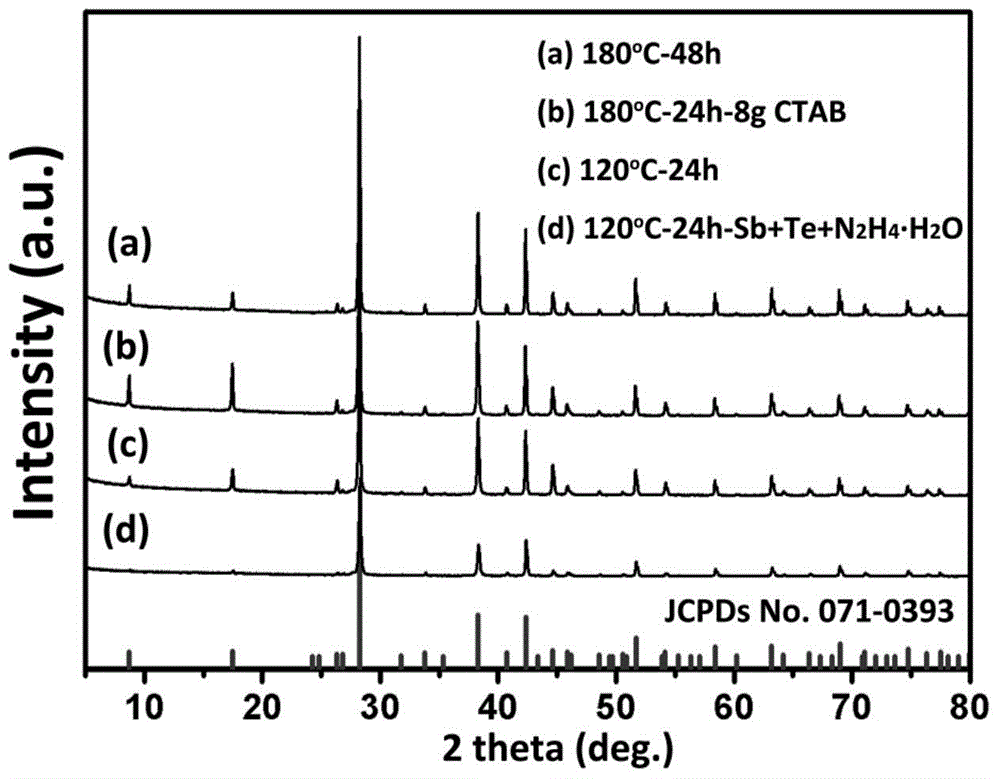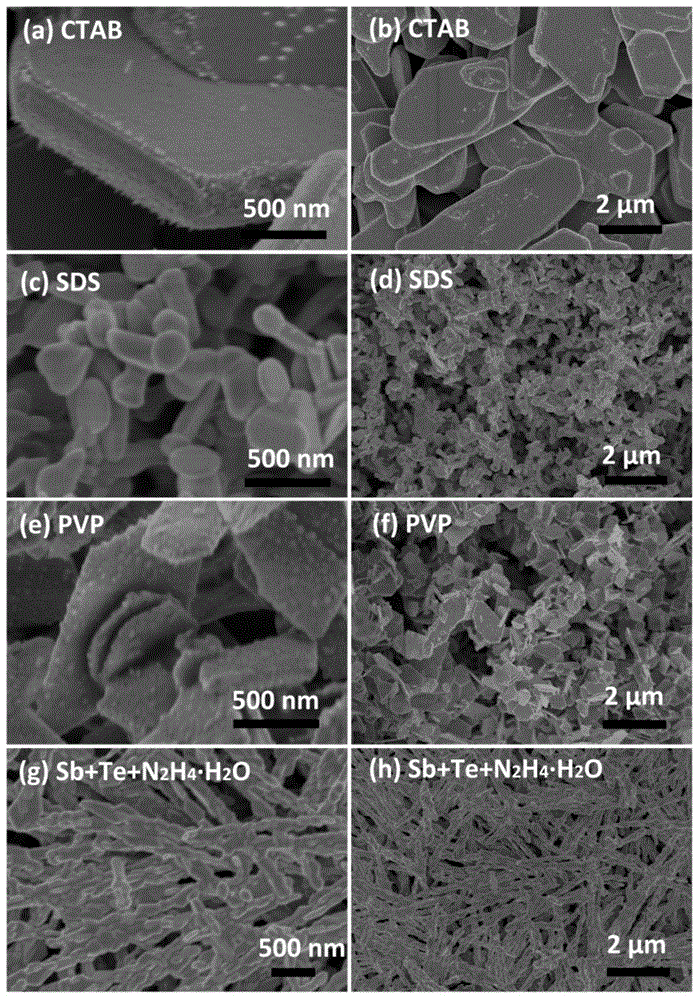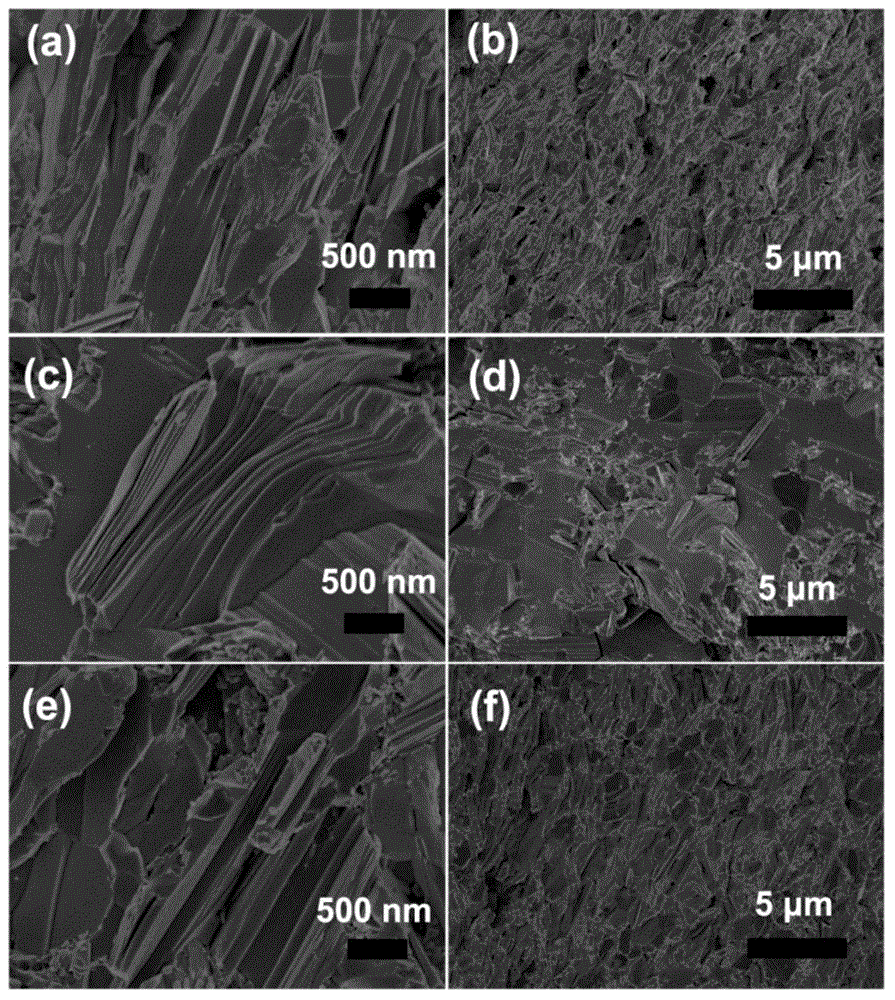Method for preparing high thermoelectrical antimony telluride micro-nano crystal and block material thereof
A technology of antimony telluride micro-nano, thermoelectric properties, applied in the direction of nanotechnology, nanotechnology, binary selenium/tellurium compounds, etc., can solve the problem of large-scale production of antimony telluride micro-nano crystals, low conversion efficiency, equipment Complicated problems, low cost, good thermoelectric performance, and simple preparation method
- Summary
- Abstract
- Description
- Claims
- Application Information
AI Technical Summary
Problems solved by technology
Method used
Image
Examples
Embodiment 1
[0045] Weigh 1.3950g antimony trichloride (M(SbCl 3 ) / M(TeO 2 )=0.679, molar ratio) in 50ml of ethylene glycol heated to 50 ~ 100 ℃, stirring completely dissolved and then transferred to a flask containing 1.4364g of tellurium dioxide (0.009mol) and supplemented with ethylene glycol up to 150ml, then It is placed on a heating mantle, heated to 140-180°C, and stirred for 20-40 minutes to obtain a clear and transparent solution. After cooling to 100-120°C, add 4ml of hydrazine hydrate (M(N 2 h 4 ·H 2 O) / M(TeO 2 )=8.962, molar ratio), heated to reflux at 180°C for 48h to obtain a gray precipitate. The obtained product was washed with absolute ethanol and dried in a vacuum environment at 80°C for 8 hours to obtain pure and well-crystallized antimony telluride micro-nanocrystals, whose XRD characterization is shown in figure 1 (a). The antimony telluride micro-nano crystals were cold-pressed into sheet-like blocks under a pressure of 500 MPa, and placed in a tube furnace unde...
Embodiment 2
[0047] Referring to Example 1, the difference is that after adding hydrazine hydrate, the mixture was heated to reflux at 120° C. for 24 hours to obtain a gray precipitate. The obtained product was washed with absolute ethanol and dried in a vacuum environment at 80°C for 8 hours to obtain pure and well-crystallized antimony telluride micro-nanocrystals, whose XRD characterization is shown in figure 1 (c). The antimony telluride micro-nano crystals were cold-pressed into sheet-like blocks under a pressure of 500 MPa, and placed in a tube furnace under 92% Ar + 8% H 2 Annealing at 300°C for 24h under a mixed atmosphere of a protective gas was set at 0.15 L / min, and the annealing heating rate was 5°C / min.
Embodiment 3
[0049] Weigh 1.3950g antimony trichloride (M(SbCl 3 ) / M(TeO 2 )=0.679, molar ratio) in 50ml of ethylene glycol was heated to 50 ~ 100 ℃, stirring completely dissolved and then transferred to a solution containing 1.4364g tellurium dioxide and 4.0g CTAB (M(CTAB) / M(TeO 2 ) = 1.220, molar ratio) and supplemented with ethylene glycol up to 150ml, then placed it on a heating mantle, heated to 140-180°C, stirred for 20-40min to obtain a clear and transparent solution, and cooled to 100-120 After adding 4ml hydrazine hydrate (M(N 2 h 4 ·H 2 O) / M(TeO 2 )=8.962, molar ratio), heated to reflux at 180°C for 24h to obtain a gray precipitate. The obtained product was washed with absolute ethanol and dried in a vacuum environment at 80°C for 8 hours to obtain pure antimony telluride micro-nanocrystals with good crystallinity. For the SEM characterization, see figure 2 (a).
[0050] The antimony telluride micro-nano crystals were cold-pressed into sheet-like blocks under a pressure o...
PUM
 Login to View More
Login to View More Abstract
Description
Claims
Application Information
 Login to View More
Login to View More - R&D
- Intellectual Property
- Life Sciences
- Materials
- Tech Scout
- Unparalleled Data Quality
- Higher Quality Content
- 60% Fewer Hallucinations
Browse by: Latest US Patents, China's latest patents, Technical Efficacy Thesaurus, Application Domain, Technology Topic, Popular Technical Reports.
© 2025 PatSnap. All rights reserved.Legal|Privacy policy|Modern Slavery Act Transparency Statement|Sitemap|About US| Contact US: help@patsnap.com



